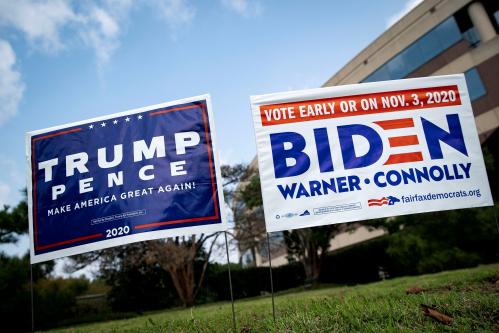President Joe Biden celebrated the first anniversary of his 2020 victory facing good news and bad about public demand for government reform and his bigger-government/more-services agenda. As my new GovLab analysis suggests, Biden should either take action to embrace government reform or risk a one-term presidency.
First, consider the public’s demand for government reform. As Figure 1 shows, demand for very major reform jumped from 52% late in Obama’s second term to 62% during the 2018 midterm elections, then retreated to 50% last June. Demand was up slightly by October in a belated confirmation of New York Times columnist Thomas Edsall’s Aug. 4 declaration that Biden’s honeymoon was over.
Figure 1
Figure 1 also suggests that economic growth drove the decline. However, even as he now pushes for increased spending, Biden would be wise to explore the demand trends in recent presidencies, most notably the increased demand for reform during the Great Recession and Trump’s first-year spike as the 2016 Russian meddling scandal took hold.
Second, consider the mixed support for Biden’s bigger-government/more-services agenda. Having promised to “spend whatever it takes, without delay” to revive the economy, Biden honored the pledge with trillions in federal spending and persistent outreach to his base. “I haven’t been able to unite the Congress,” he said last March, only days before releasing his $1.2 trillion infrastructure plan, “but I’ve been able to unite the country, based on the polling data.”
Biden was right about the deeply divided Congress, but much too hopeful about uniting the country around his agenda. Although support for a smaller government that delivers fewer services outpolled bigger government by 15% during the 2016 campaign, the two positions returned to parity by 2018 before drifting back toward the smaller-government position after Biden’s inauguration.
Figure 2
Third, consider the relative stability across the four philosophies of reform that emerge at the intersection of demand for reform and support for bigger and smaller government. As Figure 3 suggests, there has been little movement across the philosophical bounders in recent months. The number of expanders, who favor a bigger government and only some government reforms, remains fixed at about 25%; rebuilders, who favor a bigger government and very major reform, are nudging toward 30%; the percentage of streamliners, who favor a smaller government and only some reforms, also remains largely unchanged at 16%; and the dismantlers, who favor a smaller government and very major reform, are in recovery mode at 30% as Trump considers another run for the presidency.
Figure 3
Fourth, consider Biden’s approval ratings for running the federal government’s programs, which dropped following the Afghanistan withdrawal. Between June and October of 2021, Biden’s excellent/good rating fell seven points from 51% to 44%, while his fair/poor rating jumped nine points from 48% to 56%. If not a collapse, the trend matches the FiveThirtyEight tracking polls that showed Biden with a 52%/43% approval rating on Thanksgiving Day.
Even as Biden’s approval rating fell, the federal government’s rating moved in the opposite direction, rising from a 36% excellent/good mark in early summer to 41% in October as its fair/poor rating dropped from 64% to 59%. Without suggesting that Biden’s loss was the federal government’s gain, the federal government benefited by grinding away as Biden took the hit on Afghanistan.
These trends are particularly important to Biden’s standing given the recent surge in federal government breakdowns.[1] These highly visible government failures focus public attention not just on the federal government’s need for reform, but also on the president’s role in making government work. Biden has faced just six breakdowns thus far, including the border surge, confusing pandemic policies and booster schedules, the Colonial Pipeline hack, last summer’s eviction crisis, and the chaotic Afghanistan withdrawal—all of which generated high levels of public news interest as Americans watched and worried about the outcomes.
Biden is well within the first-year averages dating back to Reagan’s second term in 1984, but may yet be tested by the bureaucratic turbulence that the Trump administration left behind. Having done little to address the federal government’s bloated hierarchies, obsolete technologies, a growing list of high-risk programs on the edge of failure, and a “federal brain-drain” as the baby boomers retire, Trump made sure that Biden would face a wave of potential breakdowns on his watch. Figure 4 shows the threat to Biden’s presidency if the breakdowns continue to rise.
Figure 4
New York Times columnist Paul Krugman was right last February when he called Biden “the big spender America wants.” Given the continued threat of government breakdowns and their potential impact on public approval, Biden must also become the bureaucratic repairman the federal government desperately needs. A build back bureaucratic reform agenda is not just essential for faithful execution of Biden’s expansionist policy agenda, it provides full-throated response to the emerging Republican narrative of White House “incompetence and calamities,” a growing list of “failed presidency” op-eds, and the return of “fraud, waste, and abuse” to the GOP attack agenda.
- I define a government breakdown as (1) a demonstrable failure in a federal government policy or program that (2) receives heavy news coverage and (3) provokes high levels of public interest. We could also refer to the following footnote from my new report: “I introduced the basic concept of government breakdowns in my 2015 Volcker Alliance report: ‘Vision + Action = Faithful Execution: Why Government Daydreams and How to Stop the Cascade of Breakdowns that Now Haunts It.’ The breakdowns fall into five categories according to my past research: (1) flawed policy designs, (2) budget and staffing shortfalls that undermine implementation, (3) bureaucratic confusion and ‘regulatory capture,’ (4) leadership failures such as turnover, confirmation delays, and inexperience, and (5) misconduct and corruption.”
The Brookings Institution is committed to quality, independence, and impact.
We are supported by a diverse array of funders. In line with our values and policies, each Brookings publication represents the sole views of its author(s).











Commentary
What Americans still want from government reform: A fall 2021 update
December 8, 2021